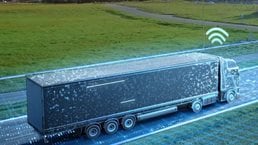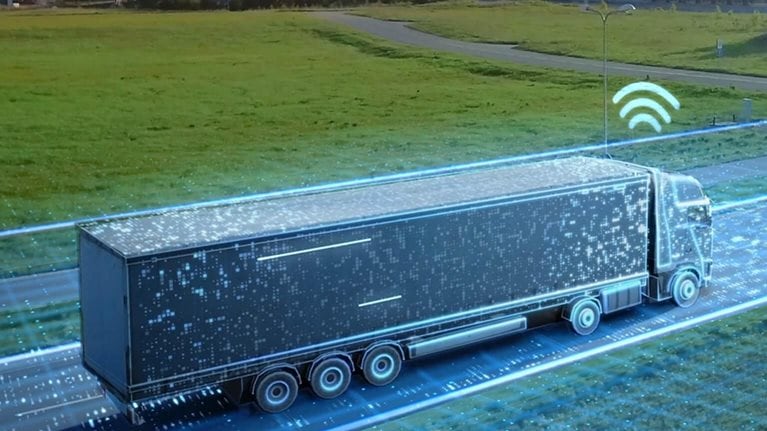There’s no doubt in David Liu’s mind that in the autonomous-vehicle race to become widely commercially available, trucks will prevail over cars. Autonomous-driving systems use self-learning AI technology, which relies on continuous inflows of information to improve. As trucks spend a lot more time on the road than cars, their systems benefit from a lot more data.
Even so, Liu, the founder and CEO of autonomous-trucking company Plus, is pressing his foot down on the gas pedal to accelerate the widespread deployment of PlusDrive, his company’s highly automated-driving product for long-haul trucks. It’s safer, more environmentally friendly, and can help with the industry’s driver shortage. Autonomous-driving systems are graded from 0 to 5 based on how much human involvement is necessary. Most assisted-driving systems (commonly referred to as ADAS) found in cars today are classified as Level 2, which requires a driver to perform many functions. Level 4 (L4) is unlocked when no human intervention is needed once conditions are met for the autonomous system to engage.
The commercially available PlusDrive is an enhanced Level 2 system with more advanced functionality than ADAS systems. PlusDrive manages tasks such as overtaking, staying centered in lane, handling stop-and-go traffic, changing lanes, and merging lanes—all under the supervision of a human driver who can intervene if the need arises. A 360-degree, multimodal sensor system monitors what’s happening all around the vehicle, feeding the data into a processor that reacts accordingly. The system also optimizes energy use, which shaves off approximately 10 percent of fuel costs.
PlusDrive can be retrofitted on existing trucks or installed directly onto new trucks at the factory. In February 2021, Plus began fulfillment of Amazon’s order of 1,000 trucks installed with PlusDrive. Last year, Plus and FAW, the world’s largest heavy-truck manufacturer, started factory production of a flagship line of new highly automated trucks powered by PlusDrive. Plus also launched a pilot program with vehicle manufacturer IVECO to develop autonomous trucks for Europe.
“The need for autonomous driving technology in the transportation and trucking space is global,” says Liu on why Plus is operating in multiple regions at once. “And so is the supply chain. Most of the large technology providers and OEMs in the trucking space are global players.”
In this installment of Logistics Disruptors, Liu takes McKinsey’s Dilip Bhattacharjee on a ride in a Plus Class 8 18-wheeler to experience PlusDrive in action. He explains the technology, why it’s safer to have AI take the wheel, and how drivers and engineers collaborate to refine PlusDrive.
McKinsey: Why is Plus focused on automating driving for trucks instead of cars?
David Liu: The truck is, first of all, a productivity tool in a critical industry. Trucks may not be as sexy as robotaxis, but their economic impact is equally big, if not bigger. Trucks are on the road 60, 70 percent of the time. Cars are on the road 5 percent of the time; they’re mostly parked. If our technology works for an asset that is on the road so much of the time, it’s immensely useful. The high usage of trucks also provides a lot more information to our ODD, or operational design domain, which spells out the conditions under which the autonomous system can operate. There’s no doubt in our minds that long-haul trucking will be the first place where autonomous driving will be widely adopted.
The recent pandemic and supply chain shortages also opened our eyes to what autonomous driving can bring to the industry. Fuel and labor costs each make up about a third of the overall cost in the business. We also know there’s a long-term driver shortage. Autonomous driving will be able to address both of these issues and make an annual economic impact of about hundreds of billions of dollars.
McKinsey: Most of your competitors seem to be building self-driving trucks from scratch. How did your idea to create a system that can work for existing trucks come about?

Logistics Disruptors
Meet the companies shaping how goods will move tomorrow.
David Liu: One of the biggest “aha” moments I had was a conversation with a customer. We’d been working on Level 4 driverless trucking for a few years then, and we were conducting pilots and demos with no drivers in them in a closed environment, like a port. We were trying to sell this demo product to some of our leading fleet customers. One day, one of our fleet customers asked us, “Can you use that technology to help us improve our fleet today with drivers in them? Is it possible for you to apply that technology and turn that around and make a product for us so that we can improve our fleet today?”
It was a very simple question, but that changed our business direction entirely. For the next two to three years, we focused on turning our technology and packing that technology into a product that we can apply to fleets today. That is still essentially what our business is today. There’s a big misconception that it takes less technology to automate a “driver-in” truck than it takes to make a fully autonomous truck. In fact, it takes the same amount of technology to do both.
McKinsey: How easy is it for drivers to use PlusDrive?
David Liu: It’s important for us that the system is built by drivers, for drivers. Everything the system can do is a skill that a professional driver already has; there’s nothing new for the driver to learn. The system can execute lane changes, brakes, cut-ins, and lane merges. All the driver has to do is sync with the system and acclimate, safe in the understanding that the system does exactly the same thing as they would do, only much quicker and with a 360-degree perspective. Most drivers take no more than an hour to an hour and a half to familiarize themselves.
We’re trying to design a system that mimics the best of human driver behavior, so this requires a lot of input from professional drivers. We track how humans drive trucks, and our engineers take all that data and knowledge to program how the system functions under certain traffic situations. The engineers and drivers share a great relationship. There are no egos and we’re all working toward a common goal of developing something that will help a lot of drivers in the future. Because of this, the drivers want to share as much information as they can to help drivers and to make the job easier.
McKinsey: Safety is perhaps the biggest concern people have about autonomous driving. Yet you believe it is actually safer than humans making the driving decisions—why?
David Liu: Using the human body as an analogy, the system not only has better eyes and better ears, but also a better brain that can think of more scenarios and run more models to end up with the right decisions faster. With technology getting more and more powerful, we are better able to get more precise data—longer-range data and data with higher resolution—feeding into the central computer from all our different types of sensors. It’s like having another set of seven eyes watching all around me; it might take me a few seconds to detect a car in my blind spot, but PlusDrive is already on it. Machines don’t get tired; they obey the rules of the road, and they have no egos. This makes it much safer than a human being at the wheel.
We also have different safeguards in the system. For instance, even when autonomous driving is on, the truck driver’s hands are legally required to stay on the steering wheel. When the system senses that the driver doesn’t have their hands on the wheel—maybe they’ve fallen asleep or there’s a medical emergency—it slows the vehicle down and eventually stops. The emergency lights also come on automatically as a safety feature.
McKinsey: What about a situation where a truck has to decide between the lesser of two evils—say between running into an elderly person or a group of school children?
David Liu: You’ve already lost if you find yourself in that position—there’s no right answer, whether you’re a person or AI. Ideally, with autonomous driving, you’re less likely to get yourself into that situation.
McKinsey: What about extreme conditions, such as icy roads or bad weather?
David Liu: Whenever the truck finds itself in a scenario like heavy rain, dust storms, big winds, or icy roads, the driver may have to take over driving. We have check marks in place to determine whether the system is able to engage. If bad weather causes the sensors to have a hard time gathering the data set, it decelerates and asks the driver to take over. If the driver doesn’t take over, the truck will then come to a complete stop.
The autonomous system is designed for a specific ODD. PlusDrive is currently able to handle the majority of highway conditions in the United States, but there’s still a lot of the urban environment that is outside of the ODD. Let’s say a construction zone comes up. Because there’s a wide variety of human activity within construction zones, which are also very irregularly marked, we don’t have 100 percent confidence that they’ll conform to the standards in our system. So when a truck encounters such a situation, the driver will be prompted to drive manually.
McKinsey: How are you refining PlusDrive’s technology and expanding its ODD?
David Liu: We’re working tirelessly on that. When the trucks return to the warehouse, all the driving data is uploaded to the data center, where it is processed. For “edge cases,” including when the driver overrides the system or slams the brakes, as well as any other unique and interesting event, we record ten seconds before and after. This helps us train the system. With more driving data, we’ll be able to cover a wider range of outlier situations and, eventually, the majority of all traffic patterns.
McKinsey: What are the biggest roadblocks facing the commercial deployment of autonomous trucking?
David Liu: I think the biggest barrier is the lack of a sense of urgency. The trucking industry has been a fairly stable industry for the past decade. While people see the need, they’re asking, why do we have to make the change now?
We work with many of our customers on the fleet side to provide proof points. People need to be convinced that not only do they have this need but also that we have reliable technology that can meet their needs, can help them solve problems. And we work with OEMs to make sure that the technology works, and we can help them integrate and provide a better product for their customers. We’re also working with regulators to figure out the road map to deploy this technology in a responsible way.
McKinsey: What are the steps in this road map?
David Liu: There’s a lot of uncertainty around the exact timing of the commercialization of “driver-out” trucks. We know it’s going to take a long time. So, instead, we take a very progressive approach to try to reach that driver-out state. What we’ve done is, we take the driver-out autonomous-driving technology, the L4 technology, and we put that into a product called PlusDrive. We apply this to trucks driven by humans to make these trucks safer, easier to drive, and more sustainable.
I think the biggest unknown and unsolved problem in the autonomous-driving field is proving the technology’s reliability and maturity. As PlusDrive is widely deployed in thousands of trucks, we’ll be able to accumulate billions of miles on an annual basis. With those miles, we’ll refine our technology and use that data to validate the maturity and reliability of PlusDrive. We expect, billions of miles of data later, we’ll be able to improve the technology and also prove that it’s safer than a human driver. When we can do that, we’ll be able to deploy autonomous trucking at scale.
McKinsey: Finally, where do you see the trucking industry in a decade’s time?
David Liu: In ten years, we’ll see a mix of fully autonomous driving with highly automated driving. In certain ODDs, such as long-haul trucking with highway-to-highway traffic, there will be some lanes with fully automated trucking with no drivers in them, but most routes will still be operated by human-driven trucks equipped with HAD [highly automated driving] systems. And in other ODDs, for instance, urban driving, we’ll continue to only see trucks with drivers in them. But they’ll also be equipped with HAD products that make them safer, easier to drive, and more sustainable.


